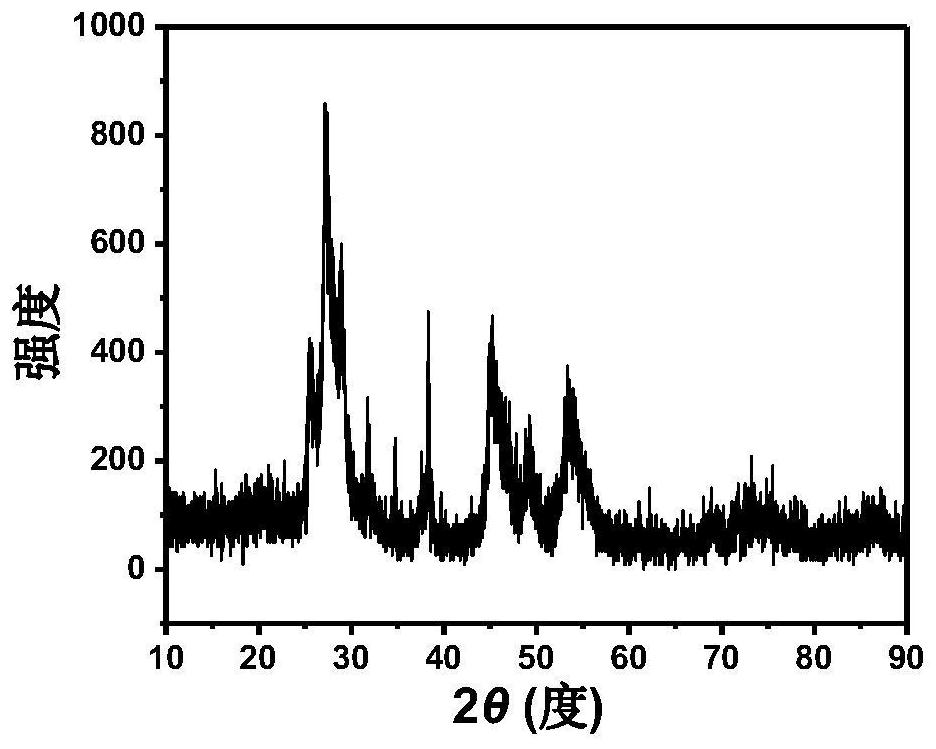B-ZCSv/Cd with B doping, S vacancy and Schottky junction, preparation method and application of B-ZCSv/Cd in production of hydrogen from dye wastewater
A Schottky junction and vacancy technology, applied in the field of photocatalysis, can solve the problems of reducing the activity of photo-splitting water for hydrogen production, slow kinetic reaction rate, etc.
- Summary
- Abstract
- Description
- Claims
- Application Information
AI Technical Summary
Problems solved by technology
Method used
Image
Examples
Embodiment 1
[0043] 10mmol Cd(Ac) 2 .2H 2 O, 10mmol Zn(Ac) 2 .2H 2 O and 20 mmol Na 2 S.9H 2 O was dissolved in 60 mL of water and stirred at room temperature to obtain a yellow suspension, which was reacted in a hydrothermal kettle at 200°C for 12 hours to obtain a yellow precipitate, which was centrifuged and dried to obtain Zn x Cd 1-x S precursor. The resulting Zn x Cd 1-x S and NaBH 4 The photocatalyst B-ZCSv / Cd-350 with B-doping, S-vacancy and Schottky junction can be obtained by grinding until uniform in a mortar, heating up to 350 degrees under nitrogen atmosphere and keeping it for 1 hour. Depend on Figure 1A It can be seen that in the prepared B-ZCSv / Cd-350, the diffraction peaks at 26.0°, 27.7°, 29.4°, 38.4°, 45.9°, 50.2° and 54.5° correspond to (100), (002), ( 101), (102), (110), (103) and (112) crystal planes (PDF 89-2943), located at 31.8°, 34.8°, 38.4° corresponding to (002), (100) and (101) of Cd ) crystal plane (PDF 85-1328), indicating that a Schottky junction...
Embodiment 2
[0045] 10mmol Cd(Ac) 2 .2H 2 O, 10mmol Zn(Ac) 2 .2H 2 O and 20 mmol Na 2 S.9H 2 O was dissolved in 60 mL of water and stirred at room temperature to obtain a yellow suspension, which was reacted in a hydrothermal kettle at 200°C for 12 hours to obtain a yellow precipitate, which was centrifuged and dried to obtain Zn x Cd 1-x S precursor. The resulting Zn x Cd 1-x S and NaBH 4 Grind it in a mortar until uniform, raise the temperature to 400 degrees under nitrogen atmosphere and keep it for 1 hour to obtain B-ZCSv / Cd-400, a photocatalyst with B doping, S vacancies and Schottky junction.
[0046] Depend on Figure 2A It can be seen that in the prepared B-ZCSv / Cd-350, the diffraction peaks at 26.0°, 27.7°, 29.4°, 38.4°, 45.9°, 50.2° and 54.5° correspond to (100), (002), ( 101), (102), (110), (103) and (112) crystal planes (PDF 89-2943), located at 31.8°, 34.8°, 38.4° corresponding to (002), (100) and (101) of Cd ) crystal plane (PDF 85-1328), indicating that a Schottk...
Embodiment 3
[0048] 10mmol Cd(Ac) 2 .2H 2 O, 10mmol Zn(Ac) 2 .2H 2 O and 20 mmol Na 2 S.9H 2 O was dissolved in 60 mL of water and stirred at room temperature to obtain a yellow suspension, which was reacted in a hydrothermal kettle at 200°C for 12 hours to obtain a yellow precipitate, which was centrifuged and dried to obtain Zn x Cd 1-x S precursor. The resulting Zn x Cd 1-x S and NaBH 4 Grind it in a mortar until uniform, raise the temperature to 500 degrees under nitrogen atmosphere and hold it for 1 hour to obtain B-ZCSv / Cd-500, a photocatalyst with B doping, S vacancies and Schottky junction.
[0049] Depend on Figure 3A It can be seen that in the prepared B-ZCSv / Cd-350, the diffraction peaks at 26.0°, 27.7°, 29.4°, 38.4°, 45.9°, 50.2° and 54.5° correspond to (100), (002), ( 101), (102), (110), (103) and (112) crystal planes (PDF 89-2943), located at 31.8°, 34.8°, 38.4° corresponding to (002), (100) and (101) of Cd ) crystal plane (PDF 85-1328), indicating that a Schottk...
PUM
 Login to View More
Login to View More Abstract
Description
Claims
Application Information
 Login to View More
Login to View More - R&D
- Intellectual Property
- Life Sciences
- Materials
- Tech Scout
- Unparalleled Data Quality
- Higher Quality Content
- 60% Fewer Hallucinations
Browse by: Latest US Patents, China's latest patents, Technical Efficacy Thesaurus, Application Domain, Technology Topic, Popular Technical Reports.
© 2025 PatSnap. All rights reserved.Legal|Privacy policy|Modern Slavery Act Transparency Statement|Sitemap|About US| Contact US: help@patsnap.com



